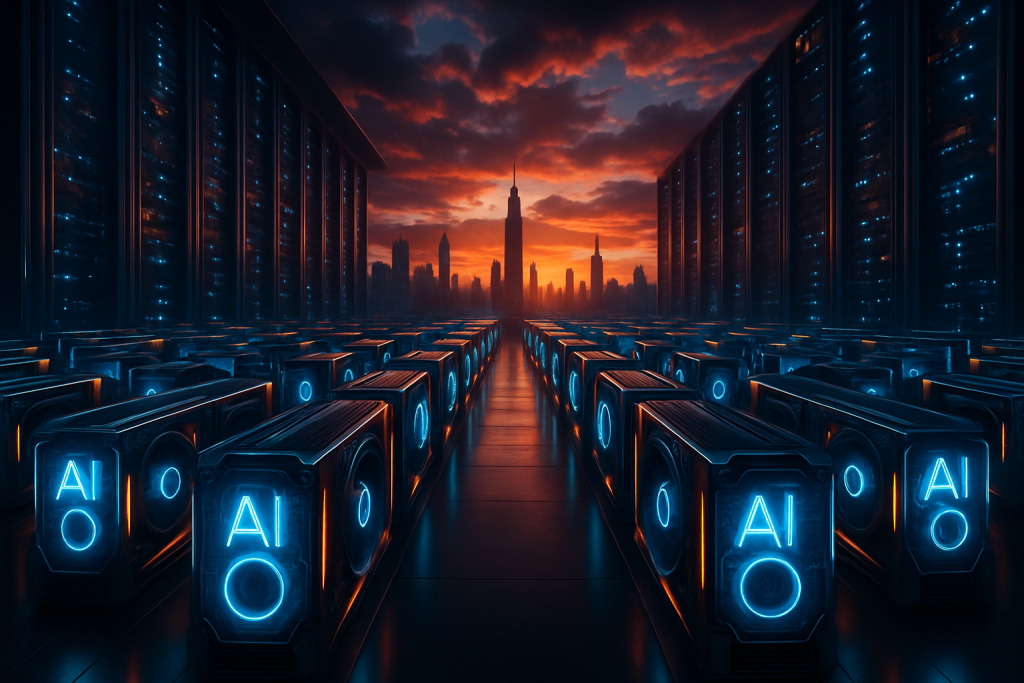The year is 2025. Flying cars are still just a pipe dream (thanks, Elon), but artificial intelligence? That’s very much a reality. And no company is riding that AI wave higher than Nvidia. Yesterday, November 20th, the company dropped its quarterly earnings report, and let’s just say it was less of a splash and more of a tsunami. $57 billion in revenue. A cool 62% jump year-over-year. Numbers that would make even Scrooge McDuck blush.
But with great power (and great revenue) comes great responsibility… and great scrutiny. The question hanging over the entire AI gold rush is this: are we in a bubble? Is this all just hype and hot air, destined to pop like a poorly inflated Bitcoin balloon? That’s the question Nvidia’s CEO, Jensen Huang, faced head-on during the earnings call. His answer? A resounding “No!”
Huang’s argument wasn’t just a dismissive wave of the hand. He painted a picture of AI investment as a fundamental infrastructure play, not a speculative gamble. Think of it like the railroads of the 19th century or the internet boom of the late 90s. Sure, there were some spectacular crashes (Pets.com, anyone?), but the underlying technology transformed society. Huang’s betting that AI is on a similar trajectory.
To understand the weight of Huang’s words, you need to understand Nvidia’s position in the AI food chain. They’re not just building AI applications; they’re building the shovels for the entire gold rush. Their graphics processing units (GPUs) are the engines that power the massive data centers of Microsoft, Amazon, Alphabet, and Meta. These aren’t your dad’s graphics cards for playing Cyberpunk 2077 (though they can certainly do that, too). These are specialized, massively parallel processors designed to crunch the insane amounts of data required to train and run AI models.
Nvidia’s dominance in this space has propelled its valuation to a staggering $4.4 trillion. That’s trillion, with a “T.” It’s a valuation that reflects not just current performance, but also the market’s belief in Nvidia’s future. But even the most ardent Nvidia bull has to acknowledge the risks. The ghost of past tech bubbles haunts the present, and the speed and scale of AI investment have raised eyebrows.
What’s fueling these bubble fears? Well, some companies, like Meta and Oracle, have been financing their AI ambitions with debt. Debt is a double-edged sword. It can supercharge growth, but it can also cripple a company if things go south. We’ve seen the consequences of this already. Following significant debt-fueled AI expansions, both Meta and Oracle experienced notable stock declines. Investors get jittery when they see companies betting the farm on unproven technologies.
Huang’s counter-argument is that Nvidia’s strong financials are a testament to genuine demand. Companies aren’t just throwing money at AI for the sake of it; they’re investing in concrete applications that are already delivering tangible results. He pointed to the development of robust AI infrastructure as the key to future innovation and efficiency across a wide range of industries. From self-driving cars to personalized medicine to hyper-realistic cat videos (priorities, people!), AI promises to transform our world.
But is it all hype? Let’s break down the technical aspects a bit. What exactly are these “AI infrastructures” that Huang is talking about? At the core, it’s about building massive data centers equipped with thousands, or even millions, of Nvidia GPUs. These data centers are then used to train AI models on vast datasets. The more data you feed an AI model, the smarter it becomes. Think of it like teaching a dog a new trick- you need to show it what to do over and over again before it finally gets it. Except in this case, the dog is a complex neural network and the trick is something like “write a sonnet in the style of Shakespeare” or “diagnose cancer from a medical image.”
The implications of Huang’s remarks are far-reaching. If he’s right, and this is a genuine infrastructure build-out, then the AI boom has legs. It means that companies will continue to invest in AI, driving demand for Nvidia’s products and services. It also means that AI will continue to improve, leading to even more applications and opportunities. But if he’s wrong, and this is a bubble, then we could be in for a painful correction. Companies that have over-invested in AI could face financial difficulties, and the entire AI ecosystem could suffer a setback.
The ethical and societal considerations are also significant. As AI becomes more powerful, it’s crucial to address issues like bias, fairness, and transparency. We need to ensure that AI is used for good, and not to perpetuate existing inequalities or create new ones. Think of the HAL 9000 in 2001: A Space Odyssey, or Skynet in the Terminator movies. While those are extreme examples, they highlight the potential dangers of unchecked AI development. We need to proceed with caution and ensure that AI remains a tool for human advancement, not a threat to our existence.
Ultimately, the question of whether or not we’re in an AI bubble remains open. Huang’s confident pronouncements have certainly reassured some investors, but skepticism persists. The next few years will be crucial in determining whether AI lives up to its promise or becomes another cautionary tale in the history of technology. For now, all eyes are on Nvidia, the company that’s either building the future or leading us towards the edge of a cliff. Only time will tell which it is.
Discover more from Just Buzz
Subscribe to get the latest posts sent to your email.


